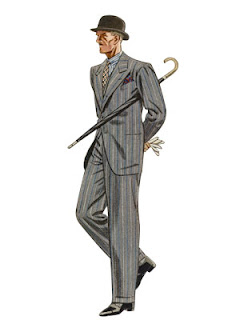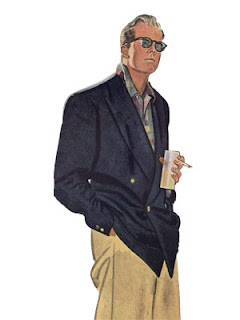An illustrated history of the last 75 years of men's fashion from double-breasted suits to modern formal wear. With some unfortunately large shoulder pads in between.
Autumn 1933

In the 1930s, bigger was better, with double-breasted suits, full-cut trousers, and tuxedos with tails setting the standard for how a gentleman should dress. Also: the dawn of shirtless sunbathing.
July 1942

In the 1940s, war changes everything. The government restricts the use of wool, and single-breasted jackets and cuff- and pleat-free pants become the norm. Once the boys come home, big style roars back with wide lapels, spread collars, and roomy suits.
October 1950

In the 1950s, conservatism and conformity rule, with trim tailoring and similar accessories (hat, pocket square, cigarette, and martini) for just about everyone. Downtime sees the occasional glimpses of flair (shantung jackets, madras prints, Hawaiian shirts).
June 1960

In the 1960s, the revolution arrives, with JFK's patrician formality giving way to flared trousers, flower shirts, wide lapels, and other assorted grooviness.
February 1970

In the 1970s, the peacock revolution leads to the rise of loose-collared culture. Deconstructed tailoring (leisure suits, et al.) takes rise and floppy collars rule.
March 1980

In the 1980s, it's morning in America, with broad shoulders framing power ties and suspenders. Bold colors and graphic patterns convey a new national confidence.
March 1991

In the 1990s, the bridge to the 21st century brings great change, with the loose, baggy silhouette of the early '90s leading to a slimmer suit profile. Business casual enters the lexicon.
September 2000

In the 2000s, men start dressing up again, and the current era of sartorial individuality -- via colors, patterns, or style -- commences.
January 2006

February 2008

Autumn 1933

In the 1930s, bigger was better, with double-breasted suits, full-cut trousers, and tuxedos with tails setting the standard for how a gentleman should dress. Also: the dawn of shirtless sunbathing.
July 1942

In the 1940s, war changes everything. The government restricts the use of wool, and single-breasted jackets and cuff- and pleat-free pants become the norm. Once the boys come home, big style roars back with wide lapels, spread collars, and roomy suits.
October 1950

In the 1950s, conservatism and conformity rule, with trim tailoring and similar accessories (hat, pocket square, cigarette, and martini) for just about everyone. Downtime sees the occasional glimpses of flair (shantung jackets, madras prints, Hawaiian shirts).
June 1960

In the 1960s, the revolution arrives, with JFK's patrician formality giving way to flared trousers, flower shirts, wide lapels, and other assorted grooviness.
February 1970

In the 1970s, the peacock revolution leads to the rise of loose-collared culture. Deconstructed tailoring (leisure suits, et al.) takes rise and floppy collars rule.
March 1980

In the 1980s, it's morning in America, with broad shoulders framing power ties and suspenders. Bold colors and graphic patterns convey a new national confidence.
March 1991

In the 1990s, the bridge to the 21st century brings great change, with the loose, baggy silhouette of the early '90s leading to a slimmer suit profile. Business casual enters the lexicon.
September 2000

In the 2000s, men start dressing up again, and the current era of sartorial individuality -- via colors, patterns, or style -- commences.
January 2006

February 2008



Nice post.this is my first time i visit here. I found so many interesting in your blog especially on how to determine the topic.network for men I haven't any word to appreciate this post. keep up the good work.
ReplyDeleteThis is very good information.i think it's useful advice. really nice blog. keep it up!!!
ReplyDelete- mens clothing burlington ma